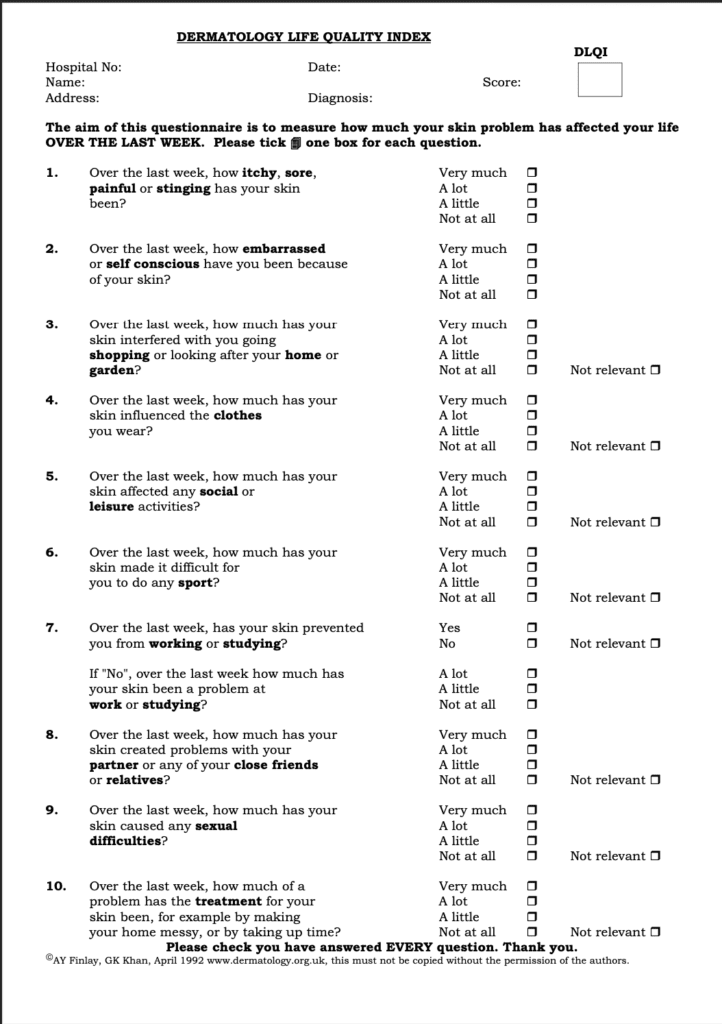The Dermatology Life Quality Index (DLQI) is an essential tool in the field of dermatology, designed to measure the impact of skin conditions on the quality of life of patients. This index helps healthcare professionals understand how a skin disease affects an individual’s daily life, guiding better treatment decisions and improving patient care. The significance of assessing quality of life in dermatology cannot be overstated, as it provides a holistic view of a patient’s well-being beyond the physical symptoms.
Table of Contents
What is The Life Quality Index in Dermatology?
The Dermatology Life Quality Index (DLQI) is an easy-to-use, validated survey that individuals can complete on their own. It is specifically created to assess the health-related quality of life in adults who are experiencing skin conditions.
Development of the DLQI
The DLQI was developed in the early 1990s by the Department of Dermatology at Cardiff University, marking a significant advancement in dermatological research. It was the first dermatology-specific quality-of-life questionnaire, setting a precedent for subsequent tools in the field. The development of the DLQI addressed a growing need to quantitatively measure the effects of skin diseases on patients’ lives, providing a standardized method to evaluate the psychological and social burdens of these conditions.

Structure of the DLQI
The DLQI questionnaire is structured around 10 questions, each designed to assess a different aspect of how skin disease affects a patient’s life. These questions cover areas such as symptoms and feelings, daily activities, leisure, work and school, personal relationships, and treatment.
Patients respond based on their experiences over the previous week, with answers scored on a scale from 0 to 3. The total score can range from 0 to 30, with higher scores indicating a greater impact on the patient’s quality of life.
This scoring system allows for a straightforward interpretation of the results, facilitating discussions between patients and healthcare providers about the disease’s impact and necessary adjustments in treatment plans.
Usage and Application
The DLQI is widely used by dermatologists, general practitioners, and other healthcare professionals involved in skin care to assess the impact of skin diseases on patients’ lives. It serves as a critical tool in both clinical practice and research settings, helping to evaluate the effectiveness of treatments and how they improve quality of life.
In pharmaceutical studies, the DLQI provides valuable data on the benefits of new drugs and therapies. It is also used by educational institutions and students specializing in dermatology to understand patient-centered care better.
Anyone aspiring to become a dermatologist receives comprehensive education that includes understanding the Dermatology Life Quality Index (DLQI), recognizing its importance in assessing the impact of skin conditions on patients’ lives. They are well-trained in utilizing this index to evaluate and improve patient care effectively.
Significance in Dermatology
The DLQI has become an indispensable tool in dermatology, highlighting the significance of quality of life in managing skin conditions. It has shifted the focus from purely clinical outcomes to a more holistic view of patient health, considering the emotional, psychological, and social aspects of skin diseases.
This shift has led to more patient-centric approaches in treatment planning and a greater understanding of the comprehensive impact of dermatological conditions on individuals’ lives.
Global Reach and Adaptations
Since its inception, the DLQI has been adapted for use in over 80 countries and translated into more than 110 languages, demonstrating its global acceptance and versatility. It has been applied to a wide range of skin conditions, from common ailments like eczema and psoriasis to rare dermatological diseases, making it a universal tool in dermatology research and practice.
This widespread use underscores the DLQI’s adaptability and relevance across different cultural and clinical contexts, enabling a standardized assessment of dermatological impact on quality of life worldwide.
Limitations and Considerations
While the DLQI is a valuable tool for assessing the quality of life in patients with skin diseases, it has its limitations. One of the main criticisms is that it may not capture all the nuances of a patient’s experience, particularly in cases of complex or multi-systemic skin conditions.
Additionally, the DLQI’s one-week recall period might not adequately reflect long-term or fluctuating conditions. There is also the potential for bias in self-reported questionnaires, where patients may overestimate or underestimate their quality of life. These factors necessitate careful interpretation of DLQI scores and, in some cases, the use of supplementary assessment tools to gain a comprehensive view of a patient’s condition.
Overall
The Dermatology Life Quality Index (DLQI) has been a groundbreaking tool in dermatology, offering significant insights into how skin conditions affect patients’ lives. Its development marked a shift towards more patient-centered care in dermatology, emphasizing the importance of quality of life in treatment outcomes.
As the field continues to evolve, the DLQI remains a fundamental component in the assessment of dermatological treatments, providing a simple yet effective measure of their impact on patients’ daily lives. Going forward, it will continue to play a crucial role in dermatological research and clinical practice, helping to ensure that patient welfare is at the heart of dermatological care.
